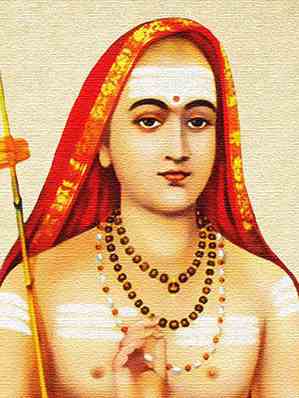SelfDefinition.Org
Parameshwar Maharaj
Submerging into Myself
Advaita in Practice
Please send suggestions to improve this translation to [email protected]

13. Beyond "Me"
Español: .. /13-mas-alla-de-mi.htm
P: Many people, with a correct understanding, can reach the state of "I Am". The understanding is being modified according to the level of, let's say it, deepening in themselves. When they realize that they are already BE, there is a tendency to "stay" there; However, that Silence and that Peace do not have their origin in him. At this point it is essential to learn to lose the sense of Being that is Existence, for that the Intelligence that is is must find the point of transcendence. It is very important that you understand that not everything ends with the Self. The Art of Abandonment reaches its mastery at this precise point.
The Being, Atman, is the cause of creation having an apparent sense of reality; this is duality. He can understand that creation and himself are the same thing and that everything begins and ends in him. As long as you hear a sound, submerged in the Self, and there is an interpretation, the matter is not finished; No matter how many thoughts or emotions do not arise, the interpretation of the impressions is telling us that the mind is not diluted in the Silence. Do you understand what I'm trying to explain?
The total Silence comes with the absorption of the mind in its totality and this means that the interpretation of creation has also been absorbed, that the fictitious point of Identity and Being, light reflected in the Absolute, have been absorbed. Being is perceived by itself and this game is contained in Lucidity. Such absorption is called by tradition as Nirvikalpa Samadhi: Sahaja and Kevala and it is collected by those who know it from their own experience. Both states come with Realization, at which time the sinking of oneself into oneself results in deep-awake Dreaming. From there (we are talking about practice and not theory), there are altered states of consciousness according to the deepening of the state, where in Kevala Nirvikalpa, consciousness still receives impressions and in Sahaja there are none. It is not what happens in them that matters, but the depth of the sinking in the Yes the interesting thing, since in both states the extinction of the Yes is a fact and the differences are only at the "knowledge" level. Both Samadhis can only be given from jagrat Sushupti, from Realization.
One moment, please.
[Parameshwar gets up and after a few moments he comes with a book written in English.]
One of the great masters of these last times, spiritual giant, declares: "If this mindless consciousness that is between deep sleep and wakefulness becomes continuous, the state that emerges then, to this the wise call it liberation".
Actually this is the only thing that matters, the deep-awake Dream, to be deeply asleep and at the same time awake. When it happens, the inner atmosphere, the state is recognized because it is the same flavor of the deep sleep in which we fall every night, only that, instead of losing consciousness as usual, the state of Lucidity is present and in both states there is no individual who lives them.
P: Are there correspondences between them? I mean, if Kevala is equivalent to Turya and Sahaja to Turyatita. The Vedanta Tradition does not make it very clear if there is correspondence or not between them.
P: All real states are given according to the degree of sinking in oneself, but if the Jagrat Sushupti is not attained it is that the self-absorption has not reached the purity required for real states of consciousness to occur. Jagrat Sushupti is the beginning of the Liberation, Turya, in it you can give both Kevala and Sahaja. According to the degree of sinking in the Yes, the mind or individuality, the sense of existence, is extinguished, jumping from Turya to Turyatita or Sahaja Nirvikalpa. Actually all this is irrelevant, and the distinction of states and their correspondence only has value for the erudition. In fact, the self-absorption must be realized until reaching Dream-awake, where the creative action of the mind or consciousness is known, it does not matter what it is called. The mind is completely submerged in the Yes so as not to reappear more. The great masters reached this point by practice and learned scholars picked up this teaching and turned it into Tradition, but they did not create relationships, they left everything untied. The Vedanta Tradition points towards these states encompassed in the Realization, but the practicing teachers did not worry about drawing a map, they only pointed out the states as points to be made, and in them this is normal, because they know the addiction of the mind to create concepts . But yes, there is a relationship between higher states.
Q: Could you give it, please?
P: I already gave it a long time ago, surely some of the regulars took note of it.
Well, it's time to start practicing. Remember, find and sink into the perception of Existence!